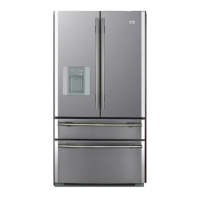English English
23
3. Icemaker Operation:
The icemaker tray periodically receives an automatic flow of water to the
icemaker ice cube tray. Once the water freezes a sensor on the tray
recognizes cubes have been made and automatically twists the tray to drop
the ice cubes into the ice bucket. Capacity of the icemaker depends on
the ambient temperature, frequency of freezer door openings, and freezer
compartment cooling temperature setting. Typically ice harvest per day is
4 pounds of ice.
4. If this is your first icemaker:
Occasionally you may hear some sounds, like flowing of water or ice cubes
dropping. These sounds are normal. Occasionally, in periods of infrequent
ice use, cubes may stick together. This is normal.
5. If you do not use ice often:
Older ice cubes can get stale. Clean the ice container periodically and
use warm water to clean. Before putting it back dry it well so cubes do not
stick to surfaces.
6. When you do not use the ice bucket for long periods of time:
If you will not be using the ice container for a long time, throw out the
remaining ice cubes, wash the container with warm water, dry it with a
towel, and place it back in the fridge. Then close the water supply valve
to the fridge.
Note:
1. Your center freezer drawer is arranged to load ice cubes on a tray in the left
side and either more ice or frequently frozen and reused foods on the right
side of the drawer.
2. When opening the center freezer drawer avoid rapid pullout, which can cause
ice cubes to fall into the lower deep freeze drawer.
3. When icemaker is dropping ice into the center drawer ice bucket, a signal of
circling dashes will appear on the dispenser clock screen. It is recommended
for the user to wait for the ice cubes to drop before opening the center freezer
drawer.
usage of iceMaker anD tHe colD Water
DisPenser (cont'D)

